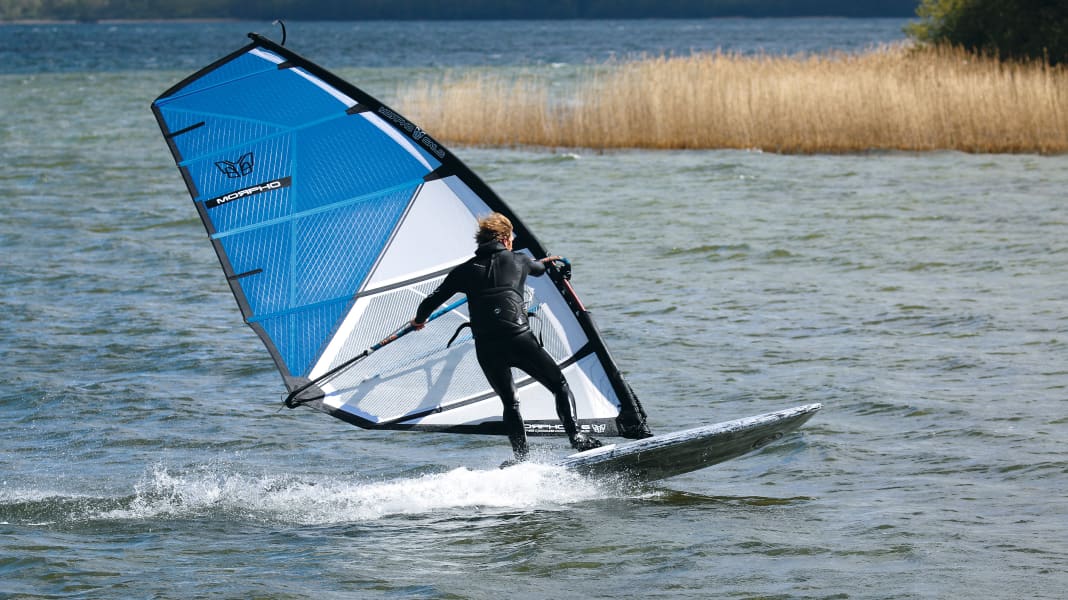
Mark, you sell the Thommen Customs brand in collaboration with shaper Peter Thommen. Where are the boards built and what is your philosophy?
Since 2004, our philosophy has been to build boards that are actually needed on the market. The prototypes are built by Peter Thommen in Scheveningen. We have a CNC machine and test on site. Production takes place at Cobra in Thailand.
Why do manufacturers always end up with Cobra in the end?
We have already had prototypes made by all the other manufacturers. We've been to Tunisia and China. Ultimately, however, the quality at Cobra is simply the best and you get the desired materials installed and on the agreed date. Many people underestimate how difficult it is to build a windsurf board.
With your range of boards, you are mainly targeting new windsurfers and those with a lower level of riding ability, aren't you?
Not only! Of course we also have boards for experienced surfers. But when, as recently, people over 70 order a model of the "gliding miracle" from us, it gives me more pleasure than building a board for a professional. Many weekend windsurfers are frustrated because they can't really get into planing. That's why we developed our "Gleitwunder" model three years ago, a shape that is classically stretched and is aimed at all those who can't manage on today's short boards or simply want to glide even earlier. The board is quite long at 265 centimetres and has a flat bottom curve for extremely harmonious planing. The glide threshold of short boards therefore does not exist.
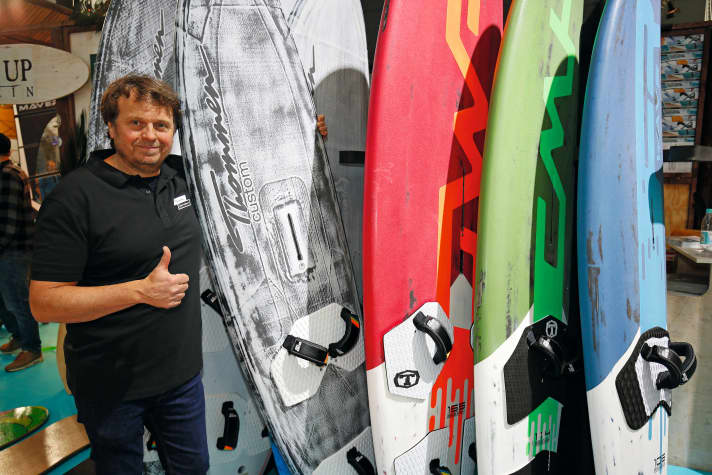
You recommend the "Gleitwunder" model with a short fin. How come?
Large freeride boards are usually equipped with long fins over 45 centimetres. These are intended to provide the necessary lift when planing. However, as soon as you start planing, a long fin is only a hindrance: in strong gusts, it produces too much buoyancy, control suffers, not to mention use in areas with shallow water. Our approach is different: we build the boards longer, making the planing surface in the underwater hull flatter and the edge longer, which improves planing and upwind performance. This makes it possible to use short fins, which in turn improves control in strong gusts.
What designs will the Gleitwunder be available in and how much will it cost?
The Thommen Sailboards, which are series boards manufactured by Cobra, will be available from the summer. The price range is between 1500 euros for the basic version and 2000 euros for an LTD version. There is also already the Thommen Custom line, made in Holland, where you can get a specific shape in various designs from extra-light to extra-stable. The prices for this: From 2550 euros. Distribution is via mark@thommen1.com, the series boards will be available via a dealer network.
You have started another project of your own with Morpho Sails, why?
I was an importer for various brands myself for many years and run two surf shops in Holland, Gearfreak. In the process, I realised that things had become far too complicated: 3-Latter, 4-Latter, Powerwave, Freewave, Freeride, and so on. All models in ten sizes and three colours. How is a shop supposed to be able to offer advice and have all the items in stock? That's why I try to keep it simple and offer a single line of sails that adapts to the area of use, depending on the size. Hence the name "Morpho Sails". In small sizes under 5.3 square metres it is a wave sail, in medium sizes it is more of an all-rounder and in large sizes it becomes a freeride sail. The manufacturers' standard model ranges are often too large, which drives up the costs for development and production.
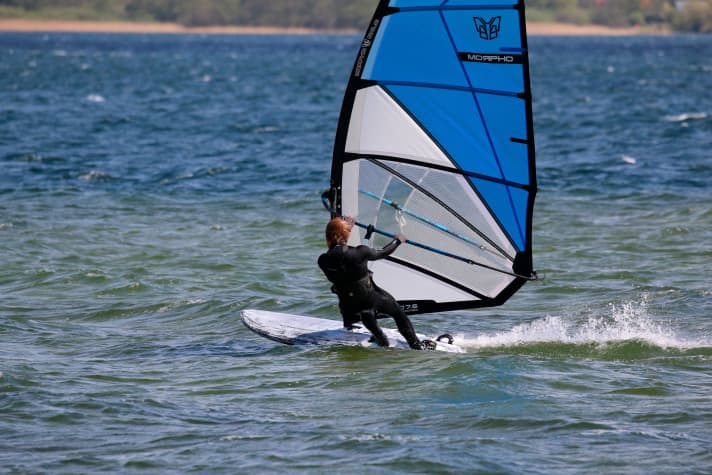
According to your statement, the large freeride sizes over 7 square metres are also designed for early planing...
Exactly. The 7.6, for example, doesn't need a lot of loose leech, you shouldn't rig it so that the entire leech creases. It is sufficient if the leech loosens a little in the area of the upper two battens. The sail should load up early and thus develop a lot of power even in light winds - so it is a good match for the planing wonder board.
Thank you Mark for the interview!
###new-page###
Test: Thommen Gleitwunder
Lake Selent seemed to us to be the perfect testing ground for the "Gleitwunder". With sails between 6.4 and 7.6 square metres, we tested whether the name of the model was the programme or just wishful thinking.
On land:
The 165-litre board is extremely relaxed to carry on the way to the water - the integrated handle makes it possible. The bottom curve is flat, the board thickness is massively reduced in the edge area via a step - this creates volume in the centre area, paired with thin rails.
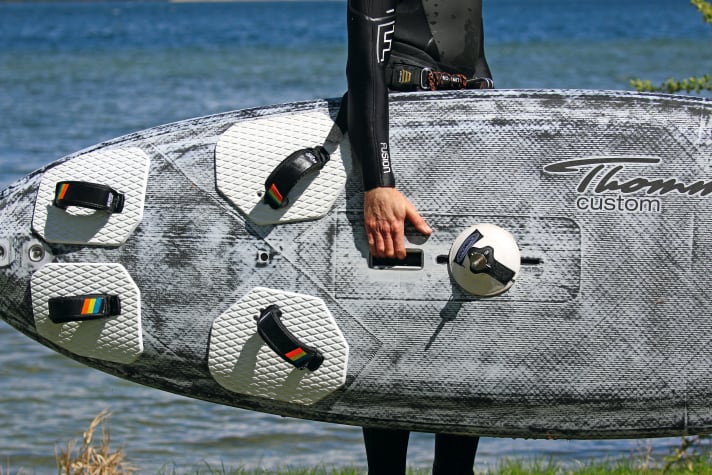
On the water:
The planing wonder is stable and well-trimmed in the water, even though it seems a little more wobbly around the longitudinal axis than other boards with comparable volume and thicker edges. On the other hand, the stretched shape is forgiving of the occasional load error when planing - the board tracks true and even if you put a little too much weight on the tail when travelling backwards, the board does not immediately turn into the wind unintentionally. Windsurfers who are just learning to planing benefit from this characteristic. The transition to planing is very harmonious and barely noticeable without a planing threshold, the sail pull is converted directly into propulsion. However, as our test fin of 37 centimetres was quite small for a board of this width, a slight headwind was helpful when planing. The acceleration of the planing wonder is what you would expect from a 165-litre board - not powerful, but definitely responsive. In full planing, the Thommen is controllable and easy to surf, the shape stoically ignores strong gusts and the risk of the nose rising uncontrollably ("wheelie") is zero. The straps are also easily accessible for intermediates, as they are located quite far inwards. Because the board is thick in the centre but thin in the edge area, you stand comfortably on a curve when gliding - there is no uncomfortable overstretching of the ankles. Only on the cross would our 90-kilo test rider have wished for a little more lift, i.e. a slightly larger fin, to minimise the easy entry of the windward edge into the chop. In manoeuvres, you benefit from the stretched shape when turning, even if the side change takes a little longer, the bow stays up. The board is also good at planing jibes: medium and wide jibe radii clearly suit the board best, and then the Thommen also glides well through the turn. Despite the thin edges, it is hardly possible to turn tightly, but you don't necessarily have to expect this from a 165-litre board.
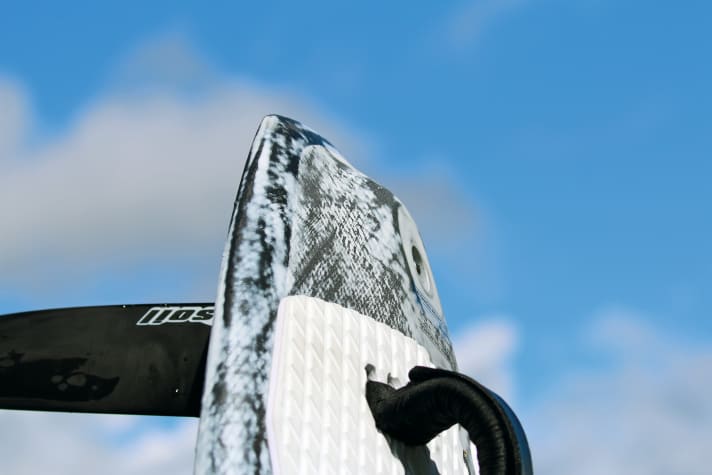
surf conclusion Thommen Gleitwunder:
Anyone who is just learning to planing and loop surfing and primarily wants to plan quickly and easily and get into the loops will certainly not be misled by the model name. Because the control in stronger winds is also impressive, the planing wonder can be said to have a wide range of uses. The plan to offer the board with a short fin is largely a success; our recommendation would be a 35 mm fin for surfers under 75 kilos and a 38 mm fin for heavier riders over 90 kilos. The concept works particularly well with camberless freeride sails, which load up well even in light winds. However, the planing wonder is not designed as a base for camber or even racing sails - the loop positions, fin gradation and, above all, the good-natured riding characteristics are unsuitable for this.
Info under www.thommen1.com
###new-page###
Test: Morpho Sails 7.6
On land:
Depending on the size, the Morpho Sails transforms from a wave sail to a camberless freeride sail. The test size of 7.6 square metres was also designed by José Fernandez. The materials appear extremely solid throughout the entire sail area, the grid material and corresponding material thickness give the sail a very high-quality appearance. The sail window made of stretchy PVC is relatively small, so the view is not quite ideal. The Morpho should indeed be rigged with comparatively moderate luff tension, but you can pull a few centimetres more on the boom than you are used to with conventional freeride sails.
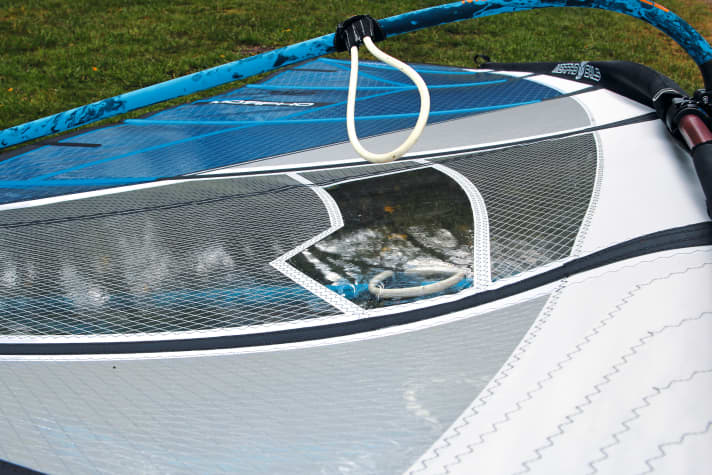
On the water:
Although the sail is very flat without wind pressure and has only a slightly pre-shaped profile, a striking profile is immediately drawn into the sail when it is hauled tight. The Morpho is balanced and calm in the hand, you immediately get some grounding on the sail hand, which makes it easier to cross the planing threshold. The soft profile is also easy to pump, and in combination with a good planing base, you have the best conditions to leave the planing threshold behind you as quickly as possible. When powered up, the sail is also powerful, although small load changes in the gusts are not completely absent in the centre trim. If it gets really windy, re-trimming is required, as the soft profile is then no longer able to stabilise the sail pressure point permanently. The handling in manoeuvres, on the other hand, is absolutely impressive, the flat profile and the buttery smooth rotation make jibes and manoeuvres really easy.
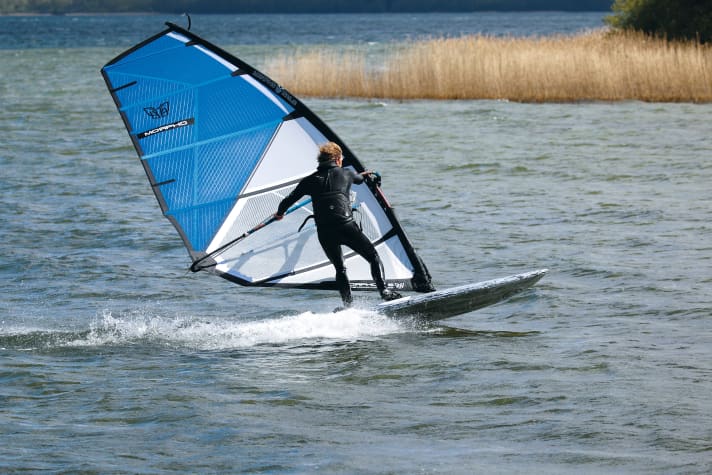
surf conclusion Morpho Sails:
The Morpho Sails is a successful early planing concept - with low trim forces, soft basic characteristics and plenty of power, it scores points with surfers who want to ride a "small" sail even in light winds and keep their hands off cloths over eight square metres as a matter of principle. This makes the Morpho Sails ideal for cruising and enjoyable heating in light winds and on freeride boards. Those who like to accelerate ambitiously and sometimes strap on a freerace board will probably miss some wind range and control in strong gusts - concepts with more basic tension and a more pre-shaped profile will serve you better.
Info under http://morphosails.com/

